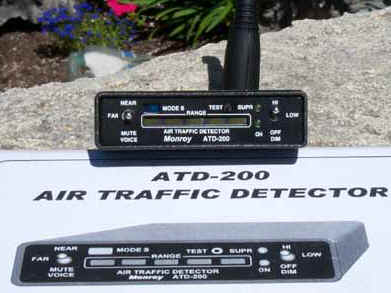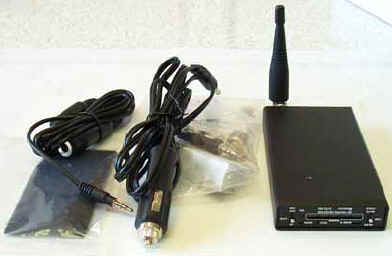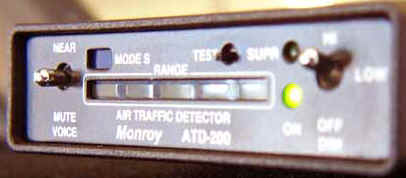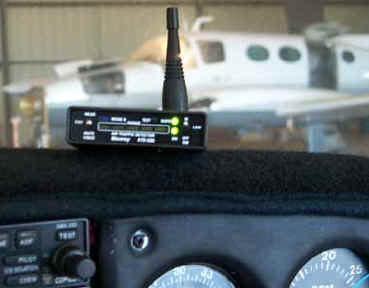new and used avionics
 Sell Your Avionics Here
Sell Your Avionics Here
|
Avionics List
new and used avionics |
 Sell Your Avionics Here
Sell Your Avionics Here
|
Buying Safety Tips |
Avionics Articles and Reviews
|
For the longest time Monroy Aerospace Corporation only sold the
ATD-200 direct and I've seen other companies do the same. They sell
direct at list price until the market is saturated and then decide it's
time for dealerships. Now avionics shops can become dealers for the
product through a distributor.
Finally, our first ATD-200 arrives and I
grab it for a product "Review". The question is; can this
little box listing for $795.00 really aid in traffic detection.
 During
the next month I was going to find out.
During
the next month I was going to find out.
The ATD-200 is manufactured by Monroy Aerospace Corp. located in
Coral Springs Florida. The receiver measures
2.75"X.75"X5.0" and weighs practically nothing. Heck,
even a hamburger is larger and weighs more than the little Monroy. The
unit comes complete with an Owner's Manual, DC power cord, audio cord,
some Velcro to fasten the unit somewhere in the cockpit and the small
rubber antenna with the proper BNC fitting installed. My kit also
contained some sheet metal "L" brackets just in case someone
wanted to mount the unit in or under the panel. The ATD-200 is
considered a portable piece of equipment, so you don't have to hassle
with the FAA, this is a good thing. Yes, you could install an antenna
mounted to the aircraft and/or hard mount the unit in the instrument
panel somewhere but that will run the cost up considerably. The ATD-200
will only operate off aircraft power (no built-in battery case).
Operating voltage is 11-30Vdc via the cigar lighter cord. Be advised
some aircraft do not have a cigar lighter receptacle or the receptacle
may be disconnected on older Cessna aircraft due to an AD on the lighter
receptacle.  To get the Monroy up and running, simply supply power to the
unit, connect the antenna and audio connections (if you want the audio)
and turn the unit on. The audio connection will plug into the aircraft
audio system or your portable intercom.
To get the Monroy up and running, simply supply power to the
unit, connect the antenna and audio connections (if you want the audio)
and turn the unit on. The audio connection will plug into the aircraft
audio system or your portable intercom.
The Owner's Manual leaves something to be desired. There're
differences in the way the unit really operates as compared to what the
manual says and a few sentences that contradict each other along with
several run-on sentences, a host of spelling and grammar errors, much
like you might find on this website. I called Monroy twice with a couple
of operations questions I had with relationship to the product. Each
time I called, Mr. Monroy answered the phone personally and did his best
to answer my questions. I was impressed with their customer service;
today it's a rare find to deal with a company that has humans
answering the phone but Monroy Aerospace does and in my opinion offers
excellent customer service. The Owner's Manual states that the ATD-200
can pickup large aircraft up to seven miles out. My first question to
Monroy was how could the unit tell if the aircraft is seven miles out
when LED display measures a maximum of only five miles? Mr. Monroy's
answer was "IF" the five-mile LED is illuminated AND the blue
Mode S lamp is on, "chances are" it's an airliner that's
five to seven miles out. The ATD-200 will only warn you of other
aircraft within 2,500ft vertical separation or at three nautical miles
out or 1,500ft vertical separation within one nautical mile. Monroy says
the ATD-200 looks at your transponder mode C output and compares it to
other aircraft's mode C and if the other aircraft are within the
perimeters of the table below, you'll get a audio warning. This is a
good thing; traffic well above or below you will not be a threat to the
ATD-200.  Fit and finish of the product are excellent.
Fit and finish of the product are excellent.
Lets go over the controls and display on the ATD-200. To the far right is the on/off, dim switch. With this switch pushed all the way down the unit is turned off; place the switch in the center position and the unit is now turned on and the display is in the "Dim" mode for night operation. By placing this switch all the way to the top position, the display goes to full bright for daytime operation. There's a LED below and to the left of the switch that illuminates when the unit turned on if the power cord is plugged in. Again, the ATD-200 only works off cigar lighter power; it does not contain any internal, replaceable batteries.
The "Voice Switch" controls the voice alert activation and is located on the far left side of the unit. Messages are provided every ten seconds but more often if things get really close or multiple threats. The "FAR" position activates all traffic voice messages. The "NEAR" position activates messages at 1 nautical mile. The "MUTE" position, well you know, mutes all the audio warnings, which is handy in busy areas.
The "SUPR" LED blinks when your aircraft transponder is replying to ATC and in some cases, annunciates when the DME is turned on and transmitting.
| What You'll See | Distance & Vertical Separation | Audio Message |
| 1 LED | 5 NM | No Message |
| 2 LED | 3 NM & within 2,500ft | "Traffic" |
| 3 LED | 2 NM | "Traffic" |
| 4 LED | 1 NM & within 1,500ft | "Traffic Nearby" |
| 5 LED | 0.5 NM | "Traffic Nearby" |
Now let's fly the ATD-200 around for a month or so. Well, after
eight flights I feel that I've got enough data to give you a realistic
opinion on just how well this unit performs. Keep in mind that in order
for the ATD-200 to operate the threatening aircraft must have a working
transponder and that transponder must be interrogated by ATC or some
other system such as a TCAS. The Monroy ATD-200 is a passive system and
will not interrogate a transponder. I found the distance displayed on
the ATD-200 had little if anything to do with the actual distance the
aircraft was away from my aircraft.  Several times I'd see an aircraft
flying parallel with me and the ATD-200 would pick it up but often the
distance would be off several miles and change even though our distance
apart hadn't changed any. Once sitting on the ground at SMX there was
a helicopter completing some fire training work near the other end of
the runway. This distance is about a mile from my location. The ATD-200
saw the helicopter but the distance would jump between .5 miles to three
miles. No, there were not any other aircraft around at this time. Often
the little ATD-200 would show aircraft 3-5 miles out that I never saw
but then one normally can't see aircraft that far out, thus I don't
know if the unit was showing me real targets or not but I'd be willing
to bet it was (more on this later). The vertical separation didn't
seem to be accurate either. Several times I received ATC reports that I
had traffic in the area in the area that were several thousand feet
above my assigned altitude and yet the ATD-200 picked up the aircraft
even though the Owner's Guide said it shouldn't have because the
altitude was more than 2,500ft. Once I had the chance to fly with
another aircraft and according to our GPS, we were three miles apart,
the other aircraft three miles directly ahead of me. At this point the
Monroy display showed bounced from two-five miles. As the other aircraft
turned ninety degrees, the unit would lose the aircraft. If the aircraft
turned again, the ATD-200 would detect the aircraft again. What I found
after experimenting around some for sometime was that detection was
based on the angle of the target aircraft. I determined that if the
threatening aircraft was flying directly toward or away from me, the
Monroy would detect it at a greater distance but if the aircraft was
flying ninety degrees to my aircraft's nose, the little Monroy wouldn't
see the threat unless the aircraft was within one mile, then it would
pick up the target. After several more weeks of using this system I
found many aircraft have blind spots and the ATD-200 correct distance
was also based on the angle of the threatening aircraft with
relationship to the nose of my aircraft. While this issue did impair the
unit at distances more than two miles, the Monroy seemed to pick up all
threats within one mile regardless of the angle. While this may not make
sense, these are the results of my test. I've found transponder power
to vary when we use our transponder test box and move the antenna around
the antenna at the same distance.
Several times I'd see an aircraft
flying parallel with me and the ATD-200 would pick it up but often the
distance would be off several miles and change even though our distance
apart hadn't changed any. Once sitting on the ground at SMX there was
a helicopter completing some fire training work near the other end of
the runway. This distance is about a mile from my location. The ATD-200
saw the helicopter but the distance would jump between .5 miles to three
miles. No, there were not any other aircraft around at this time. Often
the little ATD-200 would show aircraft 3-5 miles out that I never saw
but then one normally can't see aircraft that far out, thus I don't
know if the unit was showing me real targets or not but I'd be willing
to bet it was (more on this later). The vertical separation didn't
seem to be accurate either. Several times I received ATC reports that I
had traffic in the area in the area that were several thousand feet
above my assigned altitude and yet the ATD-200 picked up the aircraft
even though the Owner's Guide said it shouldn't have because the
altitude was more than 2,500ft. Once I had the chance to fly with
another aircraft and according to our GPS, we were three miles apart,
the other aircraft three miles directly ahead of me. At this point the
Monroy display showed bounced from two-five miles. As the other aircraft
turned ninety degrees, the unit would lose the aircraft. If the aircraft
turned again, the ATD-200 would detect the aircraft again. What I found
after experimenting around some for sometime was that detection was
based on the angle of the target aircraft. I determined that if the
threatening aircraft was flying directly toward or away from me, the
Monroy would detect it at a greater distance but if the aircraft was
flying ninety degrees to my aircraft's nose, the little Monroy wouldn't
see the threat unless the aircraft was within one mile, then it would
pick up the target. After several more weeks of using this system I
found many aircraft have blind spots and the ATD-200 correct distance
was also based on the angle of the threatening aircraft with
relationship to the nose of my aircraft. While this issue did impair the
unit at distances more than two miles, the Monroy seemed to pick up all
threats within one mile regardless of the angle. While this may not make
sense, these are the results of my test. I've found transponder power
to vary when we use our transponder test box and move the antenna around
the antenna at the same distance.
There was some good news. Twenty six times during my testing my Monroy ATD-200 detected
traffic either on the one-mile or .5 mile range and out of those twenty
six times, I physically spotted the detected aircraft twenty-six of
those times. In other words, during my testing if the display showed a
target within the one-mile or half mile range, I visually spotted the
detected aircraft 100% of the time, no false targets. After hours of
flying with this unit I feel that the target distance is grossly
incorrect, especially from the two mile and greater ranges. Also, under
some conditions the ATD-200 may not detect a target that is several
miles away. But on the other hand if the units does detect a threatening
aircraft close by, you can bet your boots it's out there. Now you don't
know the direction or altitude of that aircraft but it's out there
somewhere, you're going to have to look for the threat.
I physically spotted the detected aircraft twenty-six of
those times. In other words, during my testing if the display showed a
target within the one-mile or half mile range, I visually spotted the
detected aircraft 100% of the time, no false targets. After hours of
flying with this unit I feel that the target distance is grossly
incorrect, especially from the two mile and greater ranges. Also, under
some conditions the ATD-200 may not detect a target that is several
miles away. But on the other hand if the units does detect a threatening
aircraft close by, you can bet your boots it's out there. Now you don't
know the direction or altitude of that aircraft but it's out there
somewhere, you're going to have to look for the threat.
Bottom line is, the Monroy ATD-200 isn't a SkyWatch or Ryan TCAD by any means but it doesn't cost $17,000.00 either. Personally I wouldn't own an aircraft without some type of TCAD, either the mode S system, Ryan or Goodrich system. But if those are more than you want to bite off at the present or rent airplanes, then the Monroy ATD-200 is an item I'd recommend if you can live with its limitations. True, a keen eye outside the cockpit is one of the best collision avoidance tools we pilots have. But the added benefit of the ATD-200, especially at close ranges can enhance safety. Chances are if the Monroy ATD-200 saved your life once, it would pay for itself.